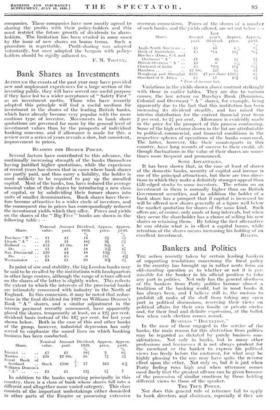Bank Shares as Investments
ALTHOUGH the events of the past year may have provided new and unpleasant experiences for a large section of the investing public, they will have served one useful purpose if they have led to a wider acceptance of " Safety First " as an investment motto. Those who have -recently adopted this principle will find a useful medium for investment in the shares of the leading British banks, which have already become very popular with the more cautious type of investor. Movements in bank share quotations are governed far more by the general level of investment values than by the prospects of individual banking concerns, and if allowance is made for this, a review over a series of years reveals a slow, but consistent, improvement in prices.
REASONS FOR HIGHER PRICES.
Several factors have contributed to this advance, the continually increasing strength of the banks themselves having justified higher quotations, while the experience of recent years has shown that in cases where bank shares are partly paid, and thus carry a liability, the holder is most unlikely to be required to pay up the uncalled capital. Most of the banks, too, have reduced the average nominal value of their shares by introducing a new class of capital, or by subdividing their former shares into units of smaller denomination. Bank shares have there- fore become attractive to a wider circle of investors, and the consequent rise in prices has correspondingly reduced the investment yields which they offer. Prices and yields on the shares of the " Big Five " banks are shown in the following table :—
Nominal Amount Dividend, -Approx. Approx.
value. paid. 1929. price. yield.
Barclays " B " £1 £1 14 21
Lloyds " A " £5
£1
161 31 51 Midland .. £12 £2 108. 18 if
£1 £1 18 311 41 Nat. Provincial .. £20 £4 18 1311 fit
£5 £5
'8
181- 411 Westminster .. £4 £1 20
311
51
In point of size and stability, the big London hanks may be said to be rivalled by the institutions with headquarters in other large centres, although the range of return offered on the shares of the latter is slightly wider. This reflects the extent to which the interests of the provincial banks are intimately concerned with industry in the North of England. In this connexion, it may be noted that reduc- tions in the final dividend for 1929 on Williams Deacon's Bank " A " shares, and a similar adjustment in the interim payment recently announced, have apparently placed the shares, temporarily at least, on a 12/. per cent. dividend basis instead of the 13'8 per cent. for last year shown below. Both in the case of this and other banks of the group, however, industrial depression has only served to emphasize the sound lines on which banking business has been conducted.
Nominal Amount Dividend, Approx. Approx.
Share. value. paid. 1929. price. yield.
% District .. .. £5 £1
k 3 61 Martins .. .. £20 £2 10s.
16 71 11 Royal Bank of
'i'.
Scotland .. Stock £1(10
117 345 411 Williams Deacon's
13}
11
7
In addition to the banks operating principally in this Country, there is a class of bank whose shares fall into. a different and altogether more varied category. This class consists of the important undertakings either domiciled in other parts of the Empire or possessing extensive
Share. overseas connexions. Prices of the shares of a number of such banks, and the yields offered, arc set out Mow : -- Last Share. Amount year's Approx. Approx. Paid. dividend. price. yield.
Anglo-South American .. 10 Bank of Australasia .. £5 .14 11I "tit Barclays (Dom.. Col. and Overseas) A " 1
British Overseas " A " 5■1
Chartered of India .. 15 "2111 171 *51 Hambros £2 10s. 221 Si Id Hongkong and Shanghai 8125 £7 per share £115.4 Standard of S. Africa .. 17 15} a Free of income tax.
Variations in the yields shown above contrast strikingly with those in earlier tables. They arc due to various causes, the low return on Barclays Bank (Dominion, Colonial and Overseas) " A " shares, for example, being apparently due to the fact that this institution has been increasing its dividend steadily, and has raised the interim distribution for the current financial year from 2 per cent. to 21 per cent. Allowance is evidently made in the price for the prospect of this process continuing. Sonic of the high returns shown in the list are attributable to political, commercial, and financial conditions in the respective spheres of operations of the banks concerned. The latter, however, like their counterparts in this country, have long records of success to their credit, al- though fluctuations in the value of their shares are some- times more frequent and pronounced.
SOME ADVANTAGES.
It has been shown that, in the case at least of shares of the domestic banks, security of capital and income is one of the principal attractions, but there are two direc- tions in which they make a definitely stronger appeal than Gilt-edged stocks to some investors. The return on an investment in them is normally higher than on British Government securities, and in addition the holder of a bank share has a prospect that if capital is increased he will be offered new shares generally at a figure well below the market quotation for shares of the same kind. Such offers are, of course, only made at long intervals, but when they occur the shareholder has a choice of selling his new shares or retaining them. By taking the first alternative he can obtain what is in effect a capital bonus, while retention of the shares means increasing his holding of an excellent investment.
















































 Previous page
Previous page